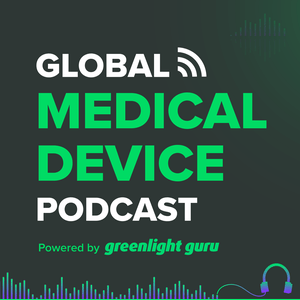#411: Unlocking U.S. MedTech Market Access: State-Specific Compliance Pitfalls Medical Device Companies Miss
Many MedTech companies focus heavily on FDA clearance but overlook a critical layer of U.S. market entry: state-level compliance. In this episode, Etienne Nichols speaks with Adam Steadman, CEO of MDD Options, to unpack the real-world challenges that derail commercialization after regulatory approval. From navigating state-specific registration, sales tax laws, and distribution logistics to choosing between direct and distributor-based strategies, Adam shares hard-earned insights for avoiding the "second valley of death" post-clearance. Whether you're a domestic startup or an international company entering the U.S., this episode arms you with a tactical understanding of compliance landmines and scalable go-to-market strategies.Key Timestamps00:02 – Intro: The real MedTech “valley of death” after FDA clearance04:45 – Why U.S. state-level registration is misunderstood and overlooked08:15 – State-level definitions of medical devices and why they differ11:20 – Strategic go-to-market options: Distribution vs. Direct17:00 – How regulations vary drastically by state (CA, TX, etc.)21:50 – The real risks of noncompliance: lawsuits, bad PR, and due diligence failures26:15 – Why distribution agreements can stall your growth (and how to avoid it)34:30 – Sales tax & use tax: The hidden compliance trap39:10 – Logistics, warehousing, and long-term liabilities in contracts44:55 – Overlooked pitfalls: Secretary of State filings and income tax in 36+ states51:15 – Software as a Medical Device (SaMD): U.S. compliance still applies55:30 – Selling to the U.S. government vs. private sector buyers59:20 – Veterinary devices and why they still need regulatory controls1:03:10 – What a winning go-to-market strategy actually looks like1:10:25 – Adam’s final advice to MedTech startups (foreign and domestic)Standout Quotes"You're not entering one country—you're entering 50 states and D.C. Each with its own rules, definitions, and tax laws."—Adam Steadman explains why U.S. MedTech entry requires a state-by-state strategy, especially for international companies."None of the strategics want your warehouse management system—they want your product, your sales, and your proof of market fit."—Steadman on why building non-core infrastructure slows down commercialization and valuation.Top 5 TakeawaysFDA Clearance ≠ Market Readiness – State-level registrations, sales tax laws, and pharmacy board definitions often delay or block commercialization.Distribution Isn’t Always a Shortcut – National distributors may have misaligned incentives and can lock you into exclusivity that hinders growth.Sales Tax is a Regulatory Minefield – 46 states require separate sales tax registration, exemptions tracking, and monthly filings—even if you're tax-exempt.Beware of Long-Term Contracts – Logistics and distribution contracts often lock companies into rigid terms that prevent pivots or acquisitions.Speed to Market Is Strategic – Getting to market fast is often the difference between becoming #1 or #3—and #3 often gets nothing.MedTech 101What Is “Nexus” and Why It Matters for Sales Tax?“Nexus” refers to the minimum level of economic activity that triggers tax obligations in a given state. For example, selling $100,000 of devices or 200 transactions may establish nexus, requiring you to register for sales tax. Unlike VAT in Europe, U.S. sales tax laws are state-specific, making this a major compliance hurdle for MedTech companies.References & Resources

